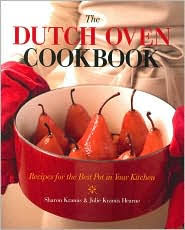My love for the culinary arts is a direct result of the absolute enjoyment my Mother takes in cooking. From her I learned the beauty of slow food, the social aspect of food, and how to share my table. I am so thankful for the delicious lessons learned in her kitchen.
This
MI-Reporter article featuring my Mom and me is so wonderful, I just couldn't resist posting some of it:
If flipping through its pages makes you want to drop what you’re doing, run to the grocery store, go home and pull out a giant mixing bowl, says Sharon Kramis, that’s the sign of a good cookbook.
Not only did the former Reporter food columnist’s new book make me wish I was at home in my kitchen, it made me wish I was in my kitchen with my mom.
“The Dutch Oven Cookbook” (Sasquatch Books) is the second labor of love Kramis has produced with her daughter, 37-year-old Julie Kramis Hearne. A celebration of “the best pot in your kitchen,” it follows “The Cast Iron Skillet Cookbook” with a hundred or so dishes, from Vietnamese pho to French beignets, that can come out of this slow-cooking cast iron pot.
The enthusiasm that mother and daughter share for the ability of both the Dutch oven and cast iron skillet to yield perfection clearly comes from a shared history of successful meals and the happy times that surround them. In a family whose cooks have done time at the Herbfarm Restaurant in Woodinville, Anthony’s Restaurants, the California Culinary Academy and the cooking school of the legendary chef James Beard, memories are stored in the porous holes of cast iron as much as on the pages of photo albums.
When it comes to what goes on in the kitchen (or over the campfire, where many of their recipes can be produced), Kramis and her daughter are of one mind. When discussing food, it’s always “we” rather than “I.” “It’s almost like we can read each other’s thoughts,” Hearne says. “When I’m cooking and I have a question, I just ask myself, ‘What would my mom do?’”
Even better than eating her mother’s food as a child, Hearne says, was helping to create it. “Making the pasta, making the sausage ... it was the whole process of baking that first loaf of bread,” she says. She recalls faking sickness so she could stay home from school to watch her mother teach classes in Sharon’s Kitchen, a cooking school Kramis ran for several her 40 years on Mercer Island. She later relished accompanying her mother as she trained with Beard at his cooking school in Seaside, Ore.
And after earning her degree in food science and nutrition (just like her mother), when Hearne met the man she would later marry, Kramis pulled from a box an old photo of Harker Hearne in the 8th grade, when he won first place in a cooking contest Kramis judged with his “Auntie Hope’s Fruit Pizza.”
“It all comes back to food,” Hearne says. (click here to read full article...)







